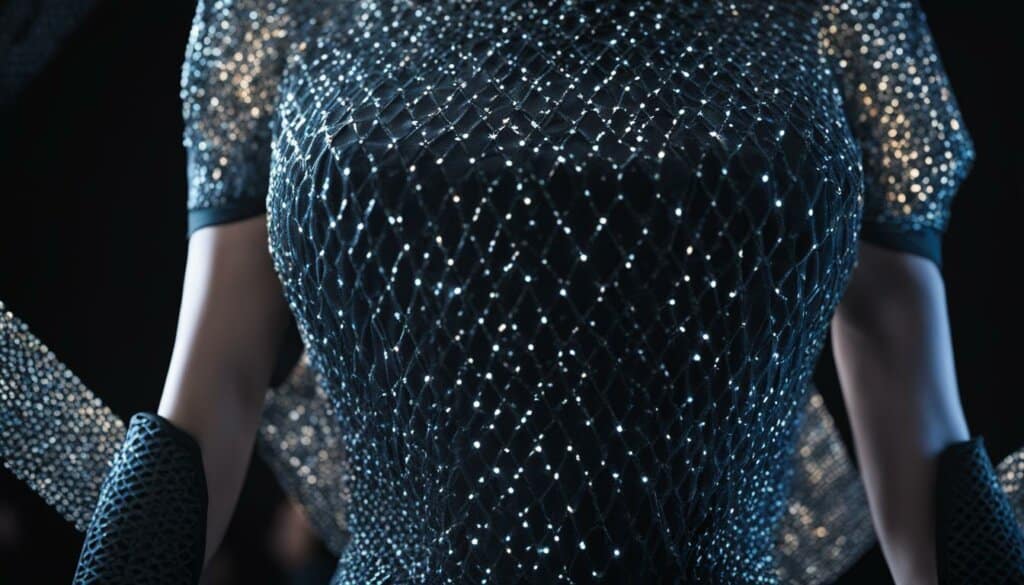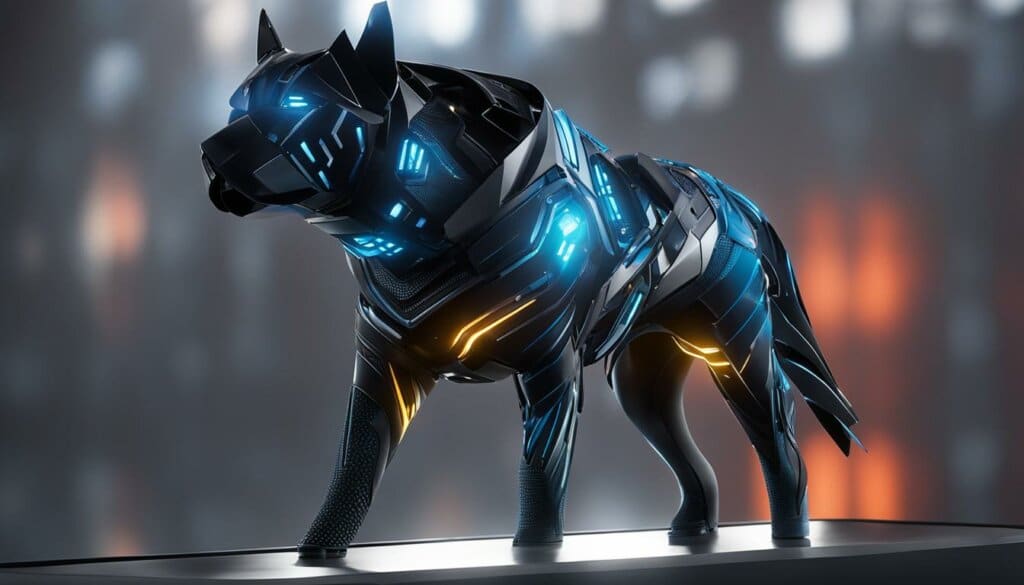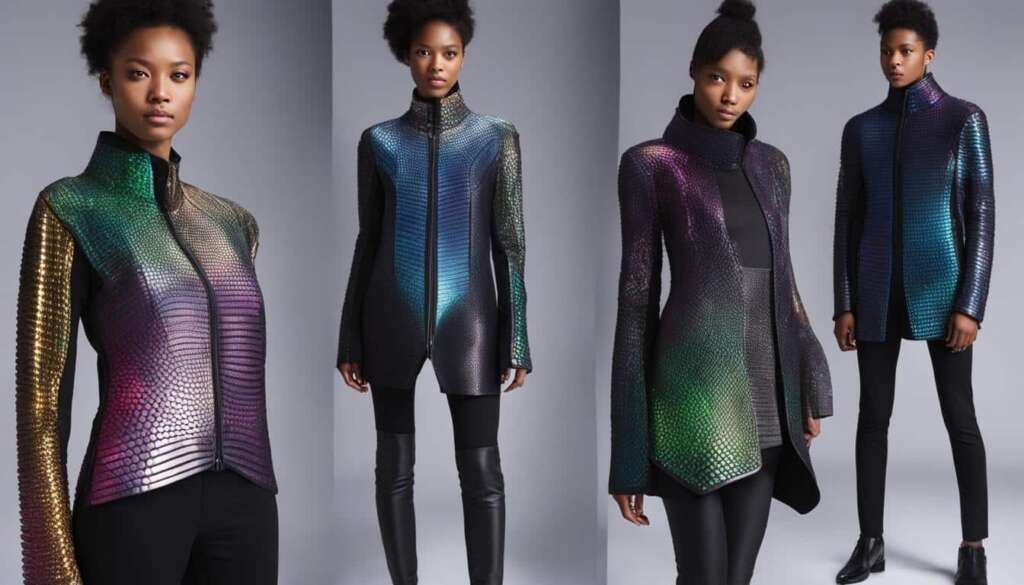Table of Contents
Nanotechnology clothing is a rapidly growing sector in the fashion industry, valued at around £5.75 billion and projected to reach £17.22 billion by 2027 with a Compound Annual Growth Rate (CAGR) of 24.6%. This innovative technology involves weaving nanoparticles or nanofibres into fabric to create clothes with enhanced properties such as water resistance, UV protection, odour resistance, stain resistance, and thermal qualities.
Nanotech clothing offers the potential to fight against microorganisms like viruses, fungi, and bacteria, making it particularly appealing in the health sector. However, concerns about the possible toxicity of nanomaterials exist, as studies suggest potential health risks if these particles enter the bloodstream.
Despite the challenges, nanotechnology and wearable technology are converging, with companies like Sonovia Tech, Nanotex, and Spiber leading the way in creating innovative nanotech clothing products. The evolution of nanotech clothing signifies the shift from aesthetics to purpose-driven attire, where fashion meets function to meet the changing needs of society.
Key Takeaways:
- Nanotechnology clothing is a rapidly growing sector in the fashion industry, projected to reach £17.22 billion by 2027.
- Nanotech clothing incorporates nanoparticles or nanofibres into fabric to enhance properties such as water resistance, UV protection, and odour resistance.
- Concerns about the toxicity of nanomaterials and potential health risks exist, but research and regulations are addressing these issues.
- Companies like Sonovia Tech, Nanotex, and Spiber are at the forefront of creating innovative nanotech clothing products.
- Nanotech clothing represents the fusion of fashion and functionality, offering attire that is stylish and serves a purpose.
The Fusion of Fashion and Functionality
Nanotechnology clothing represents the fusion of fashion and functionality, addressing the growing need for attire that is not only stylish but also serves a purpose. With shifting weather patterns, increased pollution levels, and a focus on health-consciousness, consumers are seeking clothing that offers more than just aesthetics.
Nanotech clothing uses nanoparticles or nanofibers woven into fabric to enhance garments with attributes like water resistance, UV protection, odor resistance, stain resistance, and improved thermal qualities.
This innovative technology is expected to revolutionize the fashion industry by providing clothes that not only look good but also offer practical benefits to the wearer.
The market for nanotech clothing is growing at a rapid pace, with Western Europe and the Asia Pacific leading the way in innovation and product development.
“Nanotechnology clothing represents the fusion of fashion and functionality.”
The Potential of Nanotechnology in Clothing
Nanotechnology in clothing holds immense potential, offering a range of possibilities and benefits for various industries. Nanotech clothing can provide anti-microbial properties that help combat viruses, bacteria, and fungi. Additionally, it offers water resistance, UV protection, odor resistance, stain resistance, and improved thermal qualities, making it highly versatile and suitable for applications in healthcare, sports, and outdoor activities.
Leading the way in this technological revolution are companies like Nano Textile, Colmar, eSpin Technologies, Schoeller Technologies, and BASF. They are creating innovative nanotech clothing products that seamlessly blend fashion with function, creating attire that not only looks good but also offers practical advantages.
While the potential of nanotechnology in clothing is vast, there are challenges that need to be addressed. Concerns regarding the possible toxicity of nanomaterials and the release of nanoparticles into the environment during washing require careful consideration to ensure the safety and sustainability of nanotech clothing.
Companies Driving Nanotechnology in Clothing
| Company | Key Innovations |
|---|---|
| Nano Textile | Pioneering anti-microbial nanocoatings for textiles. |
| Colmar | Specializing in high-performance nanotech sportswear. |
| eSpin Technologies | Leading the development of nanofiber-based fabrics. |
| Schoeller Technologies | Creating innovative textiles with advanced properties. |
| BASF | Exploring nanotechnology for sustainable textile solutions. |
Overcoming these challenges will ensure that nanotechnology continues to revolutionize the fashion industry, turning traditional clothing into functional and purpose-driven attire. Nanotech clothing represents the shift from mere aesthetics to attire that meets the changing needs of society, combining style, practicality, and sustainability.

The Impact of Nanotechnology in the Textile Industry
Nanotechnology has revolutionized the textile industry, particularly in the development of technical textiles. These textiles, which are one of the most profitable segments of the industry, have been able to stay ahead of the competition with the help of nanotechnology. The global market for technical textiles has seen steady growth, with a Compound Annual Growth Rate (CAGR) of 3% in terms of revenue between 2014 and 2018.
Nanotechnology has enabled the production of new fabrics with improved functions and strength, making them highly desirable in various industries such as medicine, defense, automotive, construction, and apparel. These fabrics offer enhanced properties and performance, meeting the specific needs of these industries. For example, nanotech textiles used in the medical field can provide antimicrobial properties, while those in the automotive industry can offer better durability and resistance against wear and tear.
Leading countries in the development of nanotechnology textiles include the United States, China, Canada, Germany, and India. These nations have been at the forefront of research and innovation, driving advancements in the field. Russia, too, has made significant progress in this area, showing promising potential for growth and contribution to the industry.
As nanotech clothing products continue to evolve, concerns about safety and environmental impact are being addressed. The industry is making efforts to ensure that nanotechnology is applied responsibly, taking into account potential risks and implementing necessary measures for the safe production and use of these products.
Nanotechnology has made a significant impact in the development of technical textiles, providing enhanced functions and strength to meet the specific needs of industries such as medicine, defense, automotive, construction, and apparel.
Nanotechnology Textile Development in Key Countries
| Country | Contribution in Nanotechnology Textiles |
|---|---|
| United States | Leading research and development hub, driving innovation in nanotech textiles. |
| China | Promising advancements in nanotech textiles, investing in research and fostering growth. |
| Canada | Active participant in nanotech textile research, contributing to global advancements. |
| Germany | Leading European country in nanotech textile development, integrating innovation into the industry. |
| India | Developing nanotech textiles to meet the demands of various industries, including healthcare and defense. |
| Russia | Promising growth in nanotech textile development, with potential contributions to the industry. |
The impact of nanotechnology in the textile industry is vast, providing new possibilities and advancements in technical textiles. With ongoing research and development, the industry strives to address concerns and ensure the safe and sustainable integration of nanotech clothing products. The future of nanotech textiles holds great potential, offering innovative solutions for industries and consumers alike.
Applications of Nanotechnology in Clothing
Nanotechnology has made significant contributions to the clothing industry by finding applications in various sectors. One of the fastest-growing segments benefiting from nanotechnology is sportswear and spacesuits, where it is used to enhance performance and functionality. Nanotech textiles are also widely used in the healthcare industry, leading to the development of smart surgical gloves, gowns, and other medical textiles.
Nanotechnology enables the creation of fabrics with remarkable properties, such as self-cleaning capabilities, water-repellent surfaces, and the ability to chemically target and eliminate odor-causing molecules. These advancements in nanotech clothing have opened up new possibilities for customized healthcare systems, monitoring vital signs, and adapting to changes in the weather.
For example, nanotechnology has allowed for the development of fabrics that can repel water and stains, keeping the wearer dry and clean. In addition, nanomaterials have the potential to provide thermal regulation properties, keeping individuals warm in cold weather and cool in hot weather.
| Applications of Nanotechnology in Clothing | Benefits |
|---|---|
| Sportswear and spacesuits | – Enhanced performance and functionality – Improved durability and flexibility – Moisture management capabilities |
| Healthcare industry | – Smart surgical gloves, gowns, and medical textiles – Antimicrobial properties to control infections – Protection against harmful UV radiation |
| Self-cleaning fabrics | – Removes dirt and stains easily – Reduces the need for frequent washing – Increases the lifespan of clothing |
| Odor-resistant fabrics | – Eliminates odor-causing bacteria – Provides long-lasting freshness – Reduces the need for frequent washing |
| Weather-adaptive textiles | – Adjusts to changes in temperature – Regulates body heat for comfort – Offers protection in extreme weather conditions |
Despite the numerous advantages, concerns about the release of nanoparticles into the environment during washing and potential health hazards associated with nanomaterials remain. Ensuring the safety and sustainability of nanotech clothing products is an ongoing challenge that needs to be addressed.

Global Status of Nanotechnology in Textiles
Nanotechnology in textiles is gaining momentum worldwide, with approximately 30 countries actively engaged in research and development within this field. Leading the way in nanotechnology textile innovation are the United States, China, Canada, Germany, and India. In recent years, Russia has also demonstrated a growing interest in nano-textiles, although it currently relies heavily on imports.
One notable initiative in Russia is the Nanotechnology Center of Composites, a collaborative project spearheaded by DowAksa Advanced Composites Holdings BV, Rusnano, and Holding Company Composite (HCC). This effort marks the beginning of Russia’s journey into the realm of nano-textiles, paving the way for future advancements in this area.
The global market for nanotechnology-supported technical textiles is projected to experience significant growth in various industries, including medical, defense, automotive, construction, and apparel. As nanotechnology advancements continue to unfold, textiles with enhanced properties and functionalities will play a crucial role in meeting the evolving needs of these industries.
Concerns and Challenges in Nanotech Clothing
Despite the promising benefits of nanotech clothing, there are concerns and challenges that need to be addressed. One of the main concerns is the possible toxicity of nanomaterials and the potential health risks associated with their use. Studies have shown that nanoparticles can enter the bloodstream and pose risks to human health.
Additionally, there are concerns about the release of nanoparticles into the environment during the washing of nanotech clothing, which can have potential environmental and ecological impacts.
These concerns have led to ongoing research and efforts to ensure the safety and sustainability of nanotech clothing products. Regulatory bodies like the Consumer Product Safety Commission are facing increasing challenges in regulating nanotechnology-based products and ensuring their safety for consumers and the environment.
Innovative Companies in Nanotechnology Clothing
Several companies are at the forefront of the nanotech clothing industry, driving innovation and product development. These companies are pushing the boundaries of nanotech clothing, creating products that combine fashion and function while addressing concerns about safety and sustainability.
Sonovia Tech
Sonovia Tech is a standout startup that has gained recognition for its antibacterial coatings for textiles. Using sonic waves, Sonovia Tech embeds non-toxic antibacterial substances into fabrics, offering enhanced protection against bacteria.
Nanotex
Nanotex, a company based in Oakland, California, has been pioneering the integration of nanotechnology into textiles. They have created fabrics that withstand environmental challenges and are highly durable, ensuring long-lasting performance.
Spiber
Spiber, a Japanese startup, is exploring the potential of DNA coding in proteins to develop a range of industrial materials, including textiles. Their innovative approach to creating sustainable materials is revolutionizing the nanotech clothing industry.
| Company | Description |
|---|---|
| Sonovia Tech | A standout startup recognized for its antibacterial coatings for textiles. |
| Nanotex | A company pioneering the integration of nanotechnology into textiles, creating fabrics that withstand environmental challenges. |
| Spiber | A Japanese startup exploring the potential of DNA coding in proteins to develop industrial materials, including textiles. |
These companies and others like them are revolutionizing the nanotech clothing industry, creating innovative products that combine style, functionality, and sustainability. With their groundbreaking advancements, nanotech clothing is shaping the future of the fashion industry.
Breakthrough Innovations in Nanotech Clothing
Despite the challenges and concerns surrounding nanotech clothing, breakthrough innovations continue to emerge. Companies like Nanex Company and Nano-Tex have developed unique nanotechnology-based solutions that impart desirable properties to textiles and nonwovens.
Nanex Company‘s nanocoating makes fabrics stain-resistant, while Nano-Tex has developed Aquapel, a major breakthrough in water repellence. Another innovation, NanoSphere, utilizes C6 fluorocarbon technology to create textiles with a natural self-cleaning feature.
These breakthroughs highlight the potential of nanotech clothing to revolutionize the textile industry and offer consumers products with enhanced qualities and performance. With nanex coating, fabrics become stain-resistant, reducing the need for frequent laundry and extending the lifespan of garments. Meanwhile, Aquapel’s water repellent properties ensure the wearer stays dry even in wet conditions. NanoSphere’s self-cleaning technology eliminates the need for harsh chemical treatments, promoting environmental sustainability.
By incorporating these breakthrough innovations, nanotech clothing can address the demands of consumers who seek functional and versatile apparel. With stain resistance, water repellence, and self-cleaning capabilities, nanotech clothing offers enhanced convenience, durability, and comfort.
Challenges in Adoption
High costs associated with nanotechnology remain a challenge for widespread adoption and accessibility. The development and implementation of nanotech clothing technology require significant investment in research, production processes, and specialized equipment. These expenses often translate into higher prices for nanotech clothing products, limiting their availability to a select market segment.
Additionally, the integration of nanotechnology into textile manufacturing poses technical challenges, such as ensuring uniform nanoparticle distribution and long-lasting effectiveness. Manufacturers need to develop scalable production methods that can maintain the desired properties of nanotech clothing throughout its lifespan.
The Future of Nanotech Clothing
Despite the challenges, breakthrough innovations in nanotech clothing are paving the way for a future where functional and sustainable apparel becomes the norm. As research and development efforts continue, the costs associated with nanotechnology are expected to decrease, making nanotech clothing more accessible to a wider audience.
The combination of nanotech clothing’s enhanced performance, durability, and convenience with sustainable manufacturing practices holds great promise for the future of the fashion industry. With ongoing advancements, nanotech clothing will not only revolutionize the textile industry but also contribute to a more sustainable and functional approach to fashion.
Looking Towards the Future of Nanotech Clothing
The future of nanotech clothing holds great promise, with ongoing research and advancements aiming to address the challenges and concerns associated with this technology. Companies are focused on developing nanotech clothing products that not only offer enhanced properties but also meet international environmental, health, and safety standards.
With increasing regulations and consumer awareness, textile companies are striving to uphold high standards in the production of nanotech clothing products. Additionally, technology is being integrated into textiles, with efforts to create clothing with sensing abilities and textile-based nanosensors. The potential for customized healthcare systems, monitoring vital signs, and adaptive clothing is driving the future development of nanotech clothing.
| Nanotech Clothing Innovations | Key Features |
|---|---|
 |
|
To ensure the future success of nanotech clothing, industry stakeholders must collaborate on research and development efforts, prioritizing safety, sustainability, and innovation. By addressing the challenges and concerns related to nanomaterial toxicity and environmental impact, the fashion industry can unlock the full potential of nanotech clothing, providing consumers with stylish and functional attire for years to come.
The Growing Potential of Nanotech Clothing
The potential of nanotech clothing is continuously expanding as advancements in technology and research drive new possibilities. Nanotech clothing offers a range of qualities including increased strength, lighter weight, and greater durability, making it highly desirable across various industries. Additionally, the ability to create self-cleaning, water-repellent, and odor-resistant fabrics opens up opportunities for improved products and enhanced customer experiences.
However, there are challenges that must be addressed to ensure the widespread adoption and sustainability of nanotech clothing. One of these challenges is the high cost associated with the technology, which hinders its accessibility to a wider market. Moreover, environmental concerns regarding the release of nanoparticles during production and washing need to be carefully managed to minimize potential impacts.
Despite these challenges, ongoing scientific advancements and a strong focus on addressing environmental concerns inspire confidence in the future of nanotech clothing. The industry is continuously evolving, with researchers and innovators striving to develop solutions that combine style, functionality, and sustainability.
With each technological breakthrough, nanotech clothing demonstrates its growing potential to offer innovative solutions that meet the evolving needs of consumers and industries.
| Benefits of Nanotech Clothing | Challenges in Nanotech Clothing |
|---|---|
|
|
Conclusion
The evolution of nanotechnology in clothing has brought about a paradigm shift in the fashion industry. Nanotech clothing goes beyond aesthetics, offering a range of functional benefits that cater to the changing needs of society. With the ability to create garments with enhanced properties such as water resistance, UV protection, and odor resistance, nanotech clothing has revolutionized the textile industry and opened up new possibilities for fashion design.
However, concerns surrounding the toxicity of nanomaterials and the release of nanoparticles into the environment persist. Ongoing research and development are necessary to address these challenges and ensure the safety and sustainability of nanotech clothing products. Regulatory bodies, manufacturers, and consumers must work together to establish guidelines and standards that protect both human health and the ecosystem.
Innovative companies at the forefront of nanotech clothing are pushing the boundaries of fashion and function. Through their dedication to research and development, they are driving the creation of innovative products that combine style and practicality. As technology continues to advance and environmental concerns are addressed, the future of nanotech clothing holds great promise. It offers solutions that not only meet the changing needs of consumers but also contribute to a more sustainable and responsible fashion industry.
FAQ
What is nanotechnology clothing?
Nanotechnology clothing involves weaving nanoparticles or nanofibers into fabric to create clothes with enhanced properties such as water resistance, UV protection, odor resistance, stain resistance, and thermal qualities.
What are the potential benefits of nanotechnology clothing?
Nanotechnology clothing can provide anti-microbial properties, water resistance, UV protection, odor resistance, stain resistance, and enhanced thermal qualities.
Which industries can benefit from nanotechnology clothing?
Nanotechnology clothing is widely used in industries such as healthcare, sports, and outdoor activities.
Which countries are leading in the development of nanotechnology textiles?
The United States, China, Canada, Germany, India, and Russia are actively involved in the research and development of nanotechnology textiles.
What are the concerns about nanotech clothing?
The main concerns about nanotech clothing include the possible toxicity of nanomaterials and the release of nanoparticles into the environment during washing.
Which companies are driving innovation in nanotech clothing?
Companies like Sonovia Tech, Nanotex, and Spiber are at the forefront of the nanotech clothing industry.
What are some breakthrough innovations in nanotech clothing?
Breakthrough innovations in nanotech clothing include stain resistance coatings, water repellence technologies, and self-cleaning fabrics.
What does the future hold for nanotech clothing?
The future of nanotech clothing includes ongoing research, advancements in technology, and integration of technology into textiles to create clothing with sensing abilities and textile-based nanosensors.
What is the potential of nanotech clothing?
Nanotech clothing has the potential to revolutionize the textile industry by offering enhanced qualities and performance in various industries.
Is nanotech clothing safe and sustainable?
Efforts are being made to address concerns about the safety and sustainability of nanotech clothing through ongoing research and upholding high production standards.













